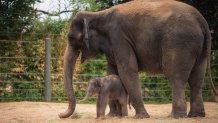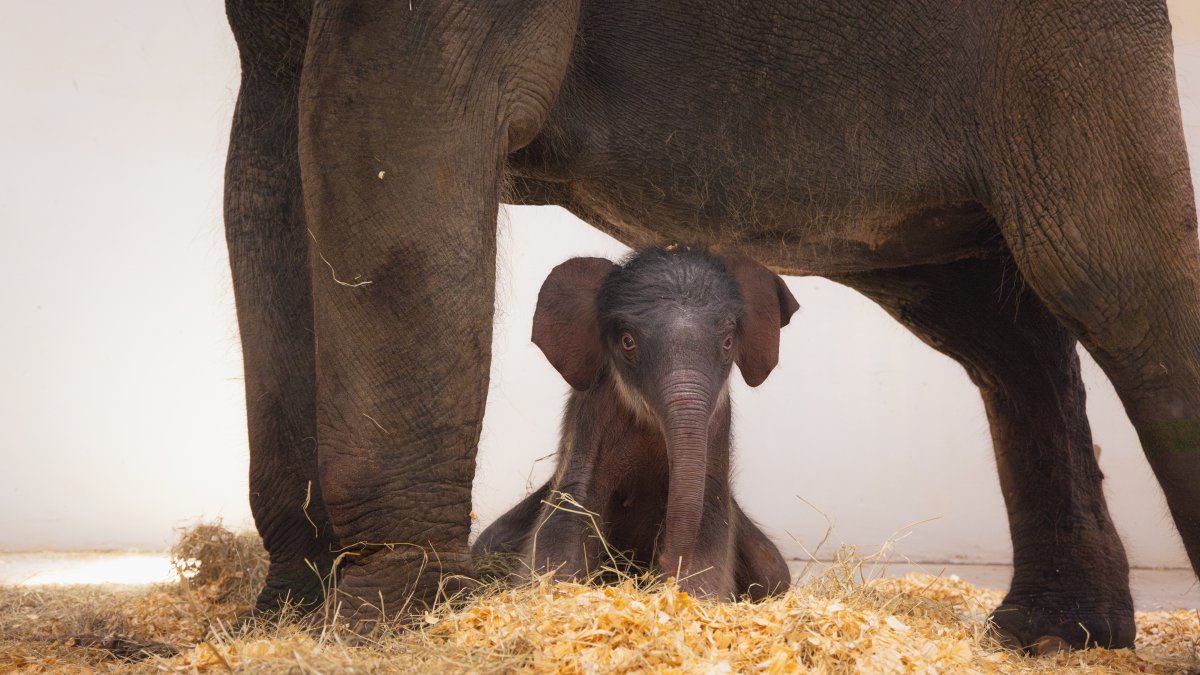The Fort Worth Zoo is celebrating the birth of the first female Asian elephant calf since 2013.
The 36-inch-tall, 250-pound calf was born at 3:36 a.m. on Aug. 18, 2025, and the zoo kept it under wraps until the announcement on Friday, Sept. 26th.
She’s now on-habitat in Elephant Springs for all to see, from 10 a.m. to 2 p.m. daily, weather permitting.
“The calf was standing within six minutes of birth, nursing within two hours, and maneuvering her trunk well almost immediately, all indications of a healthy baby elephant,” the zoo said in a news release.
Since the calf’s birth in August, she’s been bonding with her mother behind the scenes, which is crucial for the calf’s healthy development and the mother-baby bond. She’s also been getting familiar with her surroundings before making a public debut. She’s learning to swim and spending time around other members of the herd. Now that she’s been successfully introduced, she’s ready for her debut.
The bundle of joy was born to Bluebonnet, who was the first elephant calf born in the history of the Zoo in 1998. The calf’s father is Romeo, making this calf a full sibling to almost 4-year-old brother, Brazos. Mimicking herd dynamics in the wild, the newest calf joins a four-generation family of Fort Worth elephants, making matriarch Rasha one of only a few great-grandmother Asian elephants in North America.

Fort Worth Zoo
Fort Worth Zoo
All calves at the Fort Worth Zoo get Texas-themed names. Bluebonnet comes from the official state flower, and the zoo wants help in choosing what to name her calf:
- Lady Bird (“Birdie”): Named after Lady Bird Johnson, the beloved First Lady from Texas who was known for her love of nature and wildflowers. She understood the critical need for native plant life and its importance to our ecosystems. She was the driving force behind beautifying our Texas highways, planting wildflowers (like bluebonnets) along the roadways to make a lasting contribution. Lady Bird Johnson’s legacy quite literally blooms across Texas – where else can you see rainbows laid across the ground?
- Yellow Rose (“Rosie”): Her name comes from a famous Texas song and legend about the “Yellow Rose of Texas.” The song and story trace back to the 1830s when, according to legend, a woman named Emily West became part of Texas folklore as her presence helped turn the tide at the Battle of San Jacinto, paving the way for Texas’ independence.
- Black-eyed Susan (“Susie”): Named after the Texas-native wildflower that brightens fields with its golden petals and is known to attract pollinators. Hardy and full of sunshine, black-eyed Susans are a symbol of encouragement and joy.
Voting will take place now through Monday, Oct. 6, at 10 a.m. on the Fort Worth Zoo’s website. The winning name will be announced Tuesday, Oct. 7, on the Zoo’s website and social media pages.
The birth of the Asian elephant calf continues the zoo’s commitment to elephant conservation that started back in 1998 with the birth of Bluebonnet. The zoo established the global organization, International Elephant Foundation (IEF), and solidified its commitment to the care and conservation of Asian elephants.
“Asian elephants are endangered, with an estimated less than 40,000 individuals remaining in the wild, compared to hundreds of thousands of their African counterparts,” said Ramona Bass, chairman of the Fort Worth Zoo Board of Directors. “Recognizing that both species face growing threats and declining populations, we have been specifically committed to the conservation of Asian elephants since 1998, through our dedicated breeding program here in Fort Worth, while contributing to global efforts to protect elephants in the wild through IEF.”
In 2021, the zoo opened Elephant Springs, the state-of-the-art Asian elephant habitat designed to support a growing herd with features like multiple green spaces, a variety of substrates, a multitude of watering holes, and a spacious barn. Following a total of six successful elephant calf births and continued involvement in IEF, the Zoo remains an international leader in elephant breeding and conservation.
